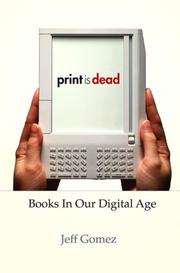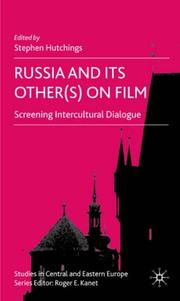| Listing 1 - 3 of 3 |
Sort by
|

ISBN: 1429954779 0230614469 Year: 2008 Publisher: New York : Palgrave Macmillan US : Imprint: Palgrave Macmillan,
Abstract | Keywords | Export | Availability | Bookmark
 Loading...
Loading...Choose an application
- Reference Manager
- EndNote
- RefWorks (Direct export to RefWorks)
For over 1500 years books have weathered numerous cultural changes remarkably unaltered. Through wars, radio, TV, computer games and fluctuating literacy rates, the book has, somewhat bizarrely, remained the more robust and culturally relevant way to communicate ideas. Now, for the first time since the Middle Ages, all that is about to change.
Culture --- Communication. --- Printing. --- Publishers and publishing. --- Text processing (Computer science). --- Educational technology. --- Popular works. --- Electronics. --- Microelectronics. --- Cultural and Media Studies. --- Media Studies. --- Popular Science, general. --- Educational Technology. --- Document Preparation and Text Processing. --- Printing and Publishing. --- Electronics and Microelectronics, Instrumentation. --- Study and teaching. --- Microminiature electronic equipment --- Microminiaturization (Electronics) --- Electronics --- Microtechnology --- Semiconductors --- Miniature electronic equipment --- Electrical engineering --- Physical sciences --- Instructional technology --- Technology in education --- Technology --- Educational innovations --- Instructional systems --- Teaching --- Processing, Text (Computer science) --- Database management --- Electronic data processing --- Information storage and retrieval systems --- Word processing --- Book publishing --- Books --- Book industries and trade --- Booksellers and bookselling --- Printing, Practical --- Typography --- Graphic arts --- Communication, Primitive --- Mass communication --- Sociology --- Cultural studies --- Aids and devices --- Publishing --- Text processing (Computer science)

ISBN: 0230517366 9780230517363 1349355097 9786611975982 1281975982 0230582788 9780230582781 9781349355099 Year: 2008 Publisher: London : Palgrave Macmillan
Abstract | Keywords | Export | Availability | Bookmark
 Loading...
Loading...Choose an application
- Reference Manager
- EndNote
- RefWorks (Direct export to RefWorks)
Russia's interactions with the West have been a perennial theme of Slavic Studies, and of Russian culture and politics. Likewise, representations of Russia have shaped the identities of many western cultures. No longer providing the 'Evil Empire' of 20th American popular consciousness, images of Russia have more recently bifurcated along two streams: that of the impoverished refugee and that of the sinister mafia gang. Focusing on film as an engine of intercultural communication, this is the first book to explore mutual perceptions of the foreign Other in the cinema of Russia and the West during, and after, communism. The book's structure reflects both sides of this fascinating dialogue: Part 1 covers Russian/Soviet cinematic representations of otherness, and Part 2 treats western representations of Russia and the Soviet Union. An extensive Introduction sets the dialogue in a theoretical context. The contributors include leading film scholars from the USA, Europe and Russia.
Motion pictures --- Outsiders in motion pictures. --- Russia (Federation) --- In motion pictures. --- Outsiders in motion pictures --- Russian Federation --- Rossiyskaya Federatsiya --- Rossiya (Federation) --- Rossii︠a︡ (Federation) --- Российская Федерация --- Rossiĭskai︠a︡ Federat︠s︡ii︠a︡ --- Російська Федерація --- Rosiĭsʹka Federat︠s︡ii︠a︡ --- Federazione della Russia --- Russische Föderation --- RF --- Federation of Russia --- Urysye Federat︠s︡ie --- Правительство России --- Pravitelʹstvo Rossii --- Правительство Российской Федерации --- Pravitelʹstvo Rossiĭskoĭ Federat︠s︡ii --- Правительство РФ --- Pravitelʹstvo RF --- Rosja (Federation) --- O-lo-ssu (Federation) --- Roshia Renpō --- Federazione russa --- OKhU --- Orosyn Kholboony Uls --- Russian S.F.S.R. --- Culture --- Communication --- Motion pictures and television --- Political science --- Cultural and Media Studies --- Media Studies --- Film History --- Film and Television Studies --- Political Science and International Relations, general --- Moving-pictures and television --- Television and motion pictures --- Television --- Administration --- Civil government --- Commonwealth, The --- Government --- Political theory --- Political thought --- Politics --- Science, Political --- Social sciences --- State, The --- Communication, Primitive --- Mass communication --- Sociology --- Cultural studies --- Study and teaching --- History --- History and criticism --- E-books --- Eluosi (Federation) --- 俄罗斯 (Federation) --- RF (Russian Federation) --- Россия (Federation)
Book
ISBN: 3540752730 9786612038174 1282038176 3540752765 Year: 2008 Publisher: Berlin ; London : Springer,
Abstract | Keywords | Export | Availability | Bookmark
 Loading...
Loading...Choose an application
- Reference Manager
- EndNote
- RefWorks (Direct export to RefWorks)
Do virtual museums really provide added value to end-users, or do they just contribute to the abundance of images? Does the World Wide Web save endangered cultural heritage, or does it foster a society with less variety? How can information technology help to preserve the diversity of cultures in our fast-changing world? These are the questions that are raised and answered in this book, the result of a long path across the digital heritage landscape. Alfredo M. Ronchi, Secretary of the EC MEDICI Cooperation Framework, gives a broad overview of eCulture and digital heritage. His presentation is divided into three main sections: the first one devoted to the main issues and general guidelines, the second to technological fundamentals and the main solutions, and the third to applications and services, including a wide range of case studies. Starting from the basics the reader will be introduced to virtual museums issues and achievements, cataloguing, digitizing, publishing, and sustainable exploitation of cultural content, all exemplified by real-world case studies and applications. Taking into account more than 15 years of experience and results in digital cultural content research, the author provides a comprehensive view on issues and achievements in digital collections and cultural content for "memory institutions", developers of digital content and digital libraries, cultural content managers, publishers, librarians, and museum curators.
Archival materials --Digitization. --- Cultural property --Protection. --- Digital preservation. --- Information technology --Social aspects. --- Virtual museums. --- Virtual museums --- Cultural property --- Archival materials --- Digital preservation --- Information technology --- History & Archaeology --- General --- Museum Publications --- History - General --- Protection --- Digitization --- Social aspects --- Digitization. --- Protection. --- Social aspects. --- Cyber museums --- Cyberspace museums --- Digital museums --- Electronic museums --- Hypermedia museums --- Meta-museums --- On-line museums --- Online museums --- Web museums --- Preservation of digital information --- Digitalization of archival materials --- Digitization of archival materials --- Culture --- Cultural heritage. --- Library science. --- Application software. --- Computers and civilization. --- Cultural and Media Studies. --- Cultural Heritage. --- Information Systems Applications (incl. Internet). --- Library Science. --- Computer Applications. --- Computers and Society. --- Study and teaching. --- Museums --- Computer files --- Digital curation --- Digital media --- Electronic preservation --- Preservation of materials --- Cultural property, Protection of --- Cultural resources management --- Cultural policy --- Historic preservation --- Conservation and restoration --- Preservation --- Government policy --- Computer science. --- Informatics --- Science --- Librarianship --- Library economy --- Bibliography --- Documentation --- Information science --- Cultural heritage --- Cultural patrimony --- Cultural resources --- Heritage property --- National heritage --- National patrimony --- National treasure --- Patrimony, Cultural --- Treasure, National --- Property --- World Heritage areas --- Civilization and computers --- Civilization --- Application computer programs --- Application computer software --- Applications software --- Apps (Computer software) --- Computer software
| Listing 1 - 3 of 3 |
Sort by
|

 Search
Search Feedback
Feedback About UniCat
About UniCat  Help
Help News
News